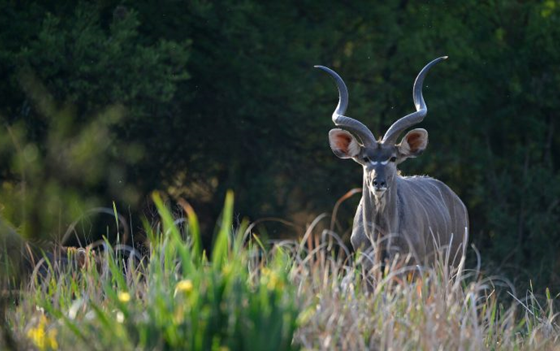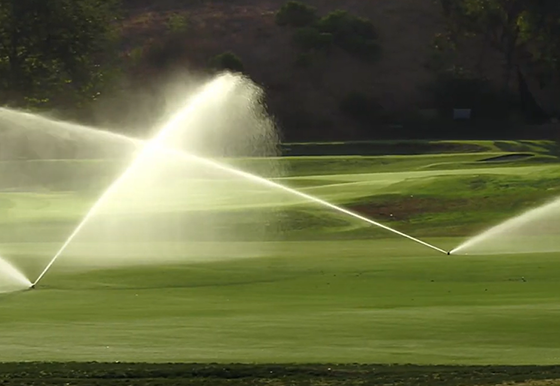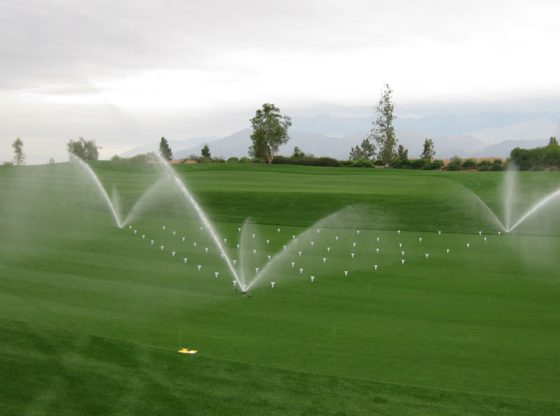Managing turfgrass can be a tricky thing. Those in the business of managing golf course turfgrass practice cultural controls at some level. Consideration, planning and execution are required in order to obtain a high-quality golf course. A variety of management techniques may be required. Be intentional with all your course practices.
Five top cultural controls you should implement in your turf grass management are:
- Aeration
- Topdressing
- Verticutting
- Water management
- Increasing height of cut
It’s important to fully understand the techniques you are or should be using. Let’s review these top five cultural controls you are most likely doing on your golf course that manipulates the growing environment.
1. Aeration
Aeration is the backbone of any cultural control program on a golf course. The question is not whether or not to aerify, but how much turf and how often.
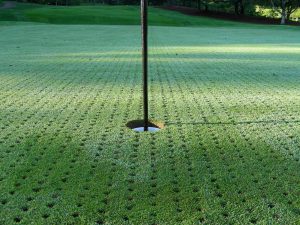 Obviously, aeration relieves soil compaction, improves oxygen availability in the root zone, increases the ability of rain and irrigation water to reach the roots, improves fertilizer uptake and reduces disease pressure. In addition, the added benefit to aeration is the increased turf density that results. More plants per square foot equals a better stand of turfgrass.
Obviously, aeration relieves soil compaction, improves oxygen availability in the root zone, increases the ability of rain and irrigation water to reach the roots, improves fertilizer uptake and reduces disease pressure. In addition, the added benefit to aeration is the increased turf density that results. More plants per square foot equals a better stand of turfgrass.
Aerification is not just for spring and fall, just like it shouldn’t be limited to only greens and tees. Fairways should be aerified twice a year, primary rough and surrounds should be done at least once yearly. High quality greens typically have a mid-summer application. Even if you’re not pulling a core, this is a high-quality maintenance technique.
2. Topdressing
Topdressing greens is another necessary control. This should be done not just in conjunction with the aerification program put in place. Done either weekly ot biweekly, light topdressing of greens is done on most high-quality cool-season turf. Other than the most obvious benefit of smoothing the playing surface, topdressing has the ability to dilute organic matter as it is produced.
3. Verticutting
Two main reasons for verticutting greens are to reduce thatch and increase density. Verticutting every other week throughout the growing season is typical for most courses. All growing programs should be scheduled accordingly. A verticutting program should match up with the bimonthly topdressing program. Most greens verticutt greens once a year at a depth og around 5/8 inch in two directions.
In relation to verticutting, a deeper thatch removal on the greens should be done once a year. Because dethatchers go much deeper, they should not be limited to just the greens. This should also be done once a year. If able, a tee and fairway program should also be implemented.
4. Water Management
Water management is very important on a course. Not only will managing the water you use save money, but also may save your turf. Water management and planning is a considerable course management tool.
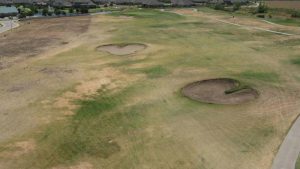 The slightest adjustments like, watering less frequently and more deeply, will encourage root growth deeper into the soil. This prevents roots from growing near the surface and forming thatch. Also, deeper roots allow plants to withstand dry conditions better.
The slightest adjustments like, watering less frequently and more deeply, will encourage root growth deeper into the soil. This prevents roots from growing near the surface and forming thatch. Also, deeper roots allow plants to withstand dry conditions better.
On the other hand, over watering results in shallow roots. This can increase the potential for soil and turf diseases to and encourages water logging. Excessive watering also stimulates weeds in the taller heights of cut.
In this age of ever-increasing watering regulations and water shortages, there is no excusable reason to over water your rough. Syringing greens during stressful periods in the heat of summer is another control method used successfully in the industry.
5. Increasing Heights of Cut
By simply increasing the height of your cut, you are doing more to combat diseases and other stresses than anything else. Dry spots, thatch diseases, and moss and algae outbreaks are all nu-senses that can be combated with a higher cut. During peak times of the season more people are trekking across turf than desired. Not being able to aerify during those times can cause turf quality to decrease. Simply raise the height of the cut to combat those issues.
This does’t just pertain to greens. Don’t cut your rough too low if you don’t have to. A higher height of cut has been proven to increase the vigor of both leaf and root growth. In addition, try and only remove one-third of the leaf blade each time you mow. Moderate trimming is the key. Reducing the leaf size also effects photosynthesis.
Just a Few More
In addition to the Big Five, there are a few other cultural controls that should be noted for achieving a quality golf course management program.
One of these is planting stress-tolerant cultivars. This should be done in the beginning, but consider replanting if not already in place. Having species that are ultimately going to allow you to have more of a chance to combat the stresses for your area and your climate is a huge factor.
Consider controlling and monitoring plant health and pest populations. Have a team in place to monitor pests and their source to insure and prevent serious damage to your course.
A quick word on rolling, which some (not me) might consider a cultural control itself. I’ve had it suggested to me that rolling greens is a form of cultural control. I get the concept, but I don’t agree. To me, a cultural control should be something done that physically improves the health of the turfgrass.
Try consciously choosing a different control method than you had planned on or that you have relied on time after time in the past. Have the ability to improvise when you see a problem developing and don’t always use the same tools. Maintaining an optimal course is a science so plan ahead and create programs to guarantee your course’s success.


